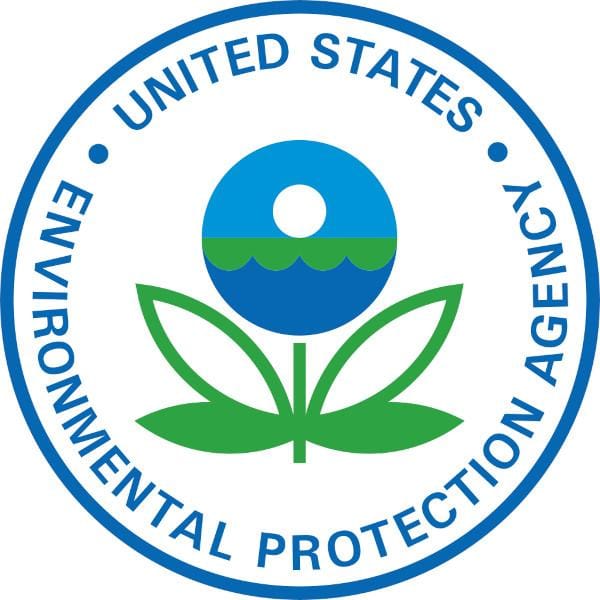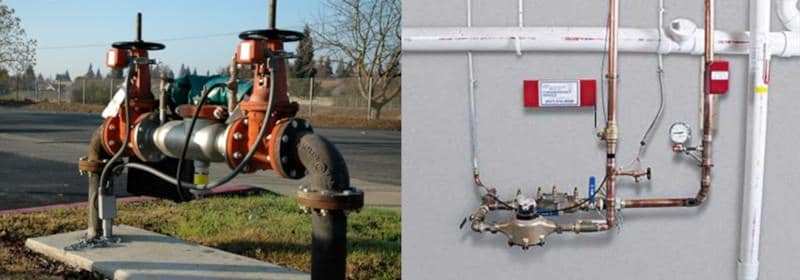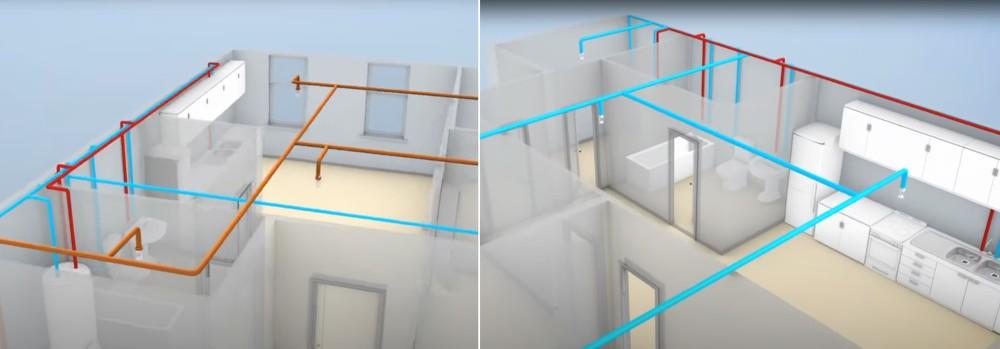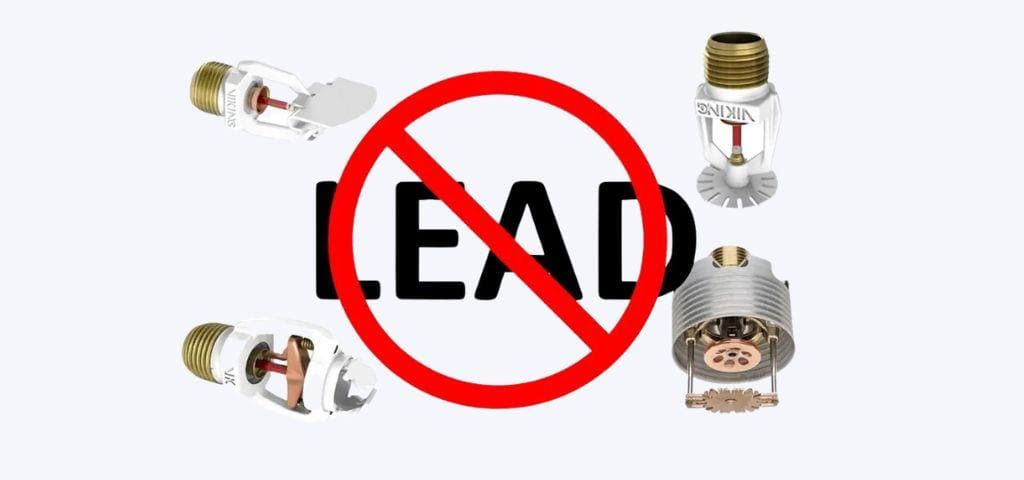Lead-free sprinklers, sometimes labeled low-lead, can be required in systems that interact with potable water
The ancient Romans used lead to make pipes, as a pottery glaze, in cosmetics, and even in their wine—and likely suffered lead poisoning. As the Centers for Disease Control explains, significant concentrations of lead that build up in the body affect the brain and nervous system, leading to lower IQs, decreased attention, and other long-term harms.
As a result, the US has banned things like lead plumbing pipes, leaded gas, and lead-based paint. However, the substance is still safely used in some materials for certain applications. And since the strictest limits on lead concentrations in plumbing apply to potable water, fixtures in non-potable piping systems, including most fire sprinkler systems, often have components that contain some lead.
When it comes to fire sprinkler systems, lead-free sprinklers, valves, and other parts become important in designs where the sprinkler water interacts with potable water, notably multipurpose residential systems.
In this article, we explain the need for and use of lead-free sprinklers, breaking down:
- Why lead is still used in brass and other alloys, including fire sprinkler parts
- An explanation of lead bans in American potable water plumbing and the sprinkler rules, including:
If you need to go lead-free for your fire protection system, QRFS stocks a wide selection of lead-free residential fire sprinklers, including these popular models:
Lead’s metallurgic properties make it useful in brass and other alloys
In the United States, it’s been decades since we first started the push to get rid of lead in pipes, gas, paint, and other sources.
However, lead is still a common additive in metal alloys like brass, which can often contain up to 2-3% lead, in addition to copper and zinc. Barring various specially manufactured models, most fire sprinklers have brass frames and often deflectors, among other alloys. Thus, most fire sprinklers currently have some lead in them.
Beyond lead’s issues in applications where humans may ingest it, it’s a pretty useful metal—it’s malleable, has a low melting point and low friction, and corrodes less than other metals. The soft gray substance is often used in brass production because leaded brass is far easier to work with in the machine shop. Lead acts as a lubricant, reducing the wear on machining tools, whereas lead-free brass causes more deterioration. Leaded brass can also be easier to solder and less susceptible to corrosion.
These benefits are why leaded brass and other alloys continue to be used in various fixtures. However, this is only possible and safe at relatively low amounts and when specific systems separate such parts from potable water supplies. As discussed in the next section, laws and regulations around lead-free solder, flux, pipe, and plumbing fixtures apply specifically to parts that can impact drinking water.
Lead-free sprinklers and drinking water regulations
The US ban on lead started in 1986, but the effort took decades to reach its current state.
Lead-free plumbing and the Safe Drinking Water Act America started clamping down on lead in plumbing with a 1986 amendment to the Safe Drinking Water Act, which banned the use of any pipe, plumbing fixture, solder, or flux “that is not lead free.” It is a benchmark year in real estate; as the US Environmental Protection Agency says, homes built afterward are much less likely to contain lead pipes. However, the 1986 definition of “lead-free” pipes was no more than 8% lead content (still relatively high compared to today’s standards), while solder and flux could only have 0.2% lead.

It wasn’t until 2011 that the passage of the Reduction of Lead in Drinking Water Act further reduced the definition of “lead-free” pipe from 8% to a weighted average of 0.25%. It’s one of the laws you’ll see referenced on data sheets for residential lead-free sprinklers (such as this one from Viking and this one from Senju).
Leaded brass is still used in many fire sprinklers, but some are specifically listed as lead-free
Most fire sprinklers have some lead in them—more than 0.25%. One reason is that the federal statutes specifically exempt “fire suppression sprinklers” (40 CFR 143.16(c)). These Reduction of Lead in Drinking Water Act rules also exempt pipes, fixtures, and fittings for plumbing not used for human consumption (think toilets) and other non-potable applications.
Alongside manufacturing and industrial applications, most fire sprinkler systems are non-potable water systems, so they don’t need to meet strict lead-free (really, ‘very very low lead’) requirements.
However, some jurisdictions and systems do require lead-free sprinklers based on:
- Specific local rules and enforcement
- Based on the type of system, its design, and how it may interact with potable water
To meet the lead-free benchmark of less than 0.25%, a sprinkler must be listed (achieve a safety certification after being tested) to show it complies with key standards published by the National Sanitation Foundation (NSF), the American National Standards Institute (ANSI), and the Canadian Standards Association (CSA). The two main standards are:
- NSF/ANSI/CAN 372: Drinking Water System Components – Lead Content ensures certified items have less than 0.25% lead. You’ll often see this standard referenced as just NSF 372.
- NSF/ANSI/CAN 61: Drinking Water System Components – Health Effects ensures an acceptable impact on health due to lead content and potential leaching. You’ll often see this standard referenced as NSF 61.
Residential sprinkler system design influences the need for lead-free sprinklers
We need to cover some system design basics before we get into where lead-free sprinklers may be required.
Most fire sprinkler systems are separated from a building’s regular plumbing. However, more of them are also still connected to the potable public water supply, and the water that sits still in many wet pipe sprinkler systems is not particularly clean.
You don’t want non-circulating water, with some resulting natural build-up of microbes, in the same pipes used for drinking. Plus, some sprinkler systems have antifreeze additives, so any of these substances or any lead that could leach into the water supply from components adds to safety concerns.
Thus, there are several residential system designs that deal with these issues differently:
1. Standalone sprinkler systems have a pipe network that’s separated from the building’s potable plumbing system, though they usually share the same supply. Since the water in the sprinkler pipes doesn’t interact with any of the home’s drinking water, sprinklers, valves, and other parts that aren’t lead-free aren’t a concern.
However, sprinkler systems are usually connected to the municipal water supply. Normally, the elevated pressure in the water main keeps liquid flowing in one direction. But if the pressure gradient is disturbed, water and contaminants could be pushed or sucked backward. So, many water authorities want to ensure backflow doesn’t occur from any water in the sprinkler pipes.
Various jurisdictions handle these issues and standalone systems differently:
- Backflow preventers: Though NFPA sprinkler installation standards (13, 13R, and 13D) don’t explicitly require them, some water authorities require systems to have backflow preventers that ensure the water only moves in one direction from the supply. You can read more about their design and function in our previous blog post. However, these devices add expense and require maintenance, which has led to some alternate solutions.
- Passive-purge designs: Passive-purge (PP) systems still separate the sprinkler system from the potable plumbing. However, they typically connect to at least one toilet in the structure, which keeps the water moving, clean, and purged when the toilet is flushed. Some modified passive purge (MPP) systems require all toilets to be “supplied from the fire sprinkler system piping,” which avoids the risk of one toilet rarely being used for flushing the system.

2. Multipurpose sprinkler systems combine a home’s potable plumbing and fire sprinkler pipe networks. Since the water regularly moves through running faucets and flushed toilets, it does not become stagnant and build up contaminants, keeping it fresh and avoiding potability concerns or backflow prevention. However, since the drinking and sprinkler water are the same, lead-free sprinklers and other fixtures become more important.

Rules for when some home sprinkler systems require lead-free sprinklers
While lead-free sprinklers aren’t necessary in most systems, they meet an essential need in a fire sprinkler system that directly interacts with potable water.
NFPA 13D: Standard for the Installation of Sprinkler Systems in One- and Two-Family Dwellings and Manufactured Homes doesn’t explicitly require lead-free sprinklers, but the need for them is still inferred and defers to local regulations. For example, here’s what NFPA 13D and the Uniform Plumbing Code (UPC) have to say:
From the 2025 edition of NFPA 13D:
6.3.2 Multipurpose piping systems shall be approved by the local plumbing or health authority.
From the 2024 edition of the Uniform Plumbing Code
612.2 Types of Systems A multipurpose fire sprinkler system shall provide potable water to both fire sprinklers and plumbing fixtures.
Remember, federal statutes define a “lead-free” component as 0.25% and say potable water supplies and components must be lead-free. So do model codes published by the International Code Council (ICC), like the International Plumbing Code (IPC) and the International Residential Code (IRC), which form the basis of state codes. For example:
From the 2021 International Residential Code
P2906.2.1 Lead content of drinking water pipe and fittings.
Pipe, pipe fittings, joints, valves, faucets and fixture fittings utilized to supply water for drinking or cooking purposes shall comply with NSF 372 and shall have a weighted average lead content of 0.25-percent lead or less.
P2906.6 Fittings.
Pipe fittings used in water supply systems shall comply with NSF 61.
So, any of these parts that come into direct contact with a potable water supply should be classified as lead-free. All states have enacted some versions of ICC codes, though jurisdictions might interpret and enforce these rules differently than others.
California is a leading example of stringent low-lead public policy. It passed California Assembly Bill 1953 (AB1953) in 2006, which lowered state standards to lead content of 0.25% or less five years before the federal government did it. These requirements are in section 116875 of the California Health and Safety Code (HSC).
Like the federal statutes, California’s regulations mention low-lead exemptions for fire sprinklers. For example, this 2011 bulletin from the California State Fire Marshal states that “the Health and Safety Code 25214.4.3 is not intended to require residential fire sprinkler heads to be tested and evaluated; and the product is excluded from the requirements of Health and Safety Code, Section 116875.”
However, a blanket exemption doesn’t seem to consider systems where the sprinklers interact with potable water, and various CA jurisdictions enforce requirements differently based on how sprinkler systems are designed. Here are two examples:
- The city of San Diego requires “sprinklers throughout the building” to “conform to the lead-free requirements in Health and Safety Code” if a passive-purge system is used and drains to anything other than a toilet.
- Citing AB 1953, Visalia, CA, states, “Only lead free sprinkler heads, valves and fittings shall be installed in multi-purpose fire sprinkler systems.”
The bottom line: while regulations and enforcement could vary, any sprinkler system that shares a structure’s potable water supply calls for lead-free sprinklers, valves, pipes, and other relevant fixtures. This naturally applies to multipurpose fire sprinkler systems and any standalone passive-purge system that drains anywhere other than toilets.
Lead-free fire sprinklers, valves, and other pipe components serve an important purpose
Lead is still present in many materials because it’s useful, and laws keep it from leaching into the main places where it could be ingested and cause health effects. Public health and water authorities have determined that some lead in alloys used in fire protection parts aren’t an issue in the majority of fire sprinkler systems based on their design.
However, be sure to check with your jurisdiction and follow the rules, especially regarding residential systems. A system that mixes fire protection water and potable water benefits from lead-free components.
QRFS has a wide selection of residential fire sprinklers for you to explore, including many lead-free options. Check sprinkler data sheets for more information on lead-free compliance and listings, and contact our customer service team with questions.
Check out these top-selling lead-free models:
This blog was originally posted at blog.qrfs.com. If this article helped you, check us out on Twitter @QuickResponseFS.


